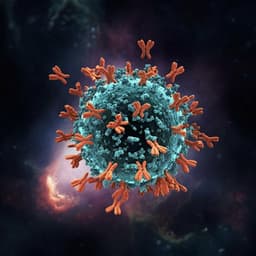
Medicine and Health
A ferritin-based COVID-19 nanoparticle vaccine that elicits robust, durable, broad-spectrum neutralizing antisera in non-human primates
P. A. Weidenbacher, M. Sanyal, et al.
Introducing DCFHP-alum, a groundbreaking ferritin-based COVID-19 vaccine that shows remarkable promise for global accessibility! Developed by a team of experts including Payton A.-B. Weidenbacher and Prabhu S. Arunchalam from Stanford University, this vaccine generates robust and lasting neutralizing antibodies against various SARS-CoV-2 variants and even SARS-CoV-1. With its impressive stability and potential for high-yield production, it could serve as a yearly booster or primary pediatric vaccine.
~3 min • Beginner • English
Introduction
The study addresses the pressing need for COVID-19 vaccines that are affordable, globally accessible, stable without stringent cold-chain requirements, and capable of inducing durable protection against evolving SARS-CoV-2 variants of concern. Despite rapid vaccine rollout, a large global population remains unvaccinated, affordability and cold-chain logistics are barriers, immunity wanes prompting frequent boosters, and immune-evasive variants continue to emerge. Protein nanoparticle vaccines offer advantages in antigen uptake and B cell activation via multivalent display. Building on prior ferritin-based SARS-CoV-2 vaccine candidates (e.g., SAC-Fer) that improved neutralizing responses by removing immunodominant linear epitopes and stabilizing the spike, the authors introduce an updated nanoparticle vaccine, DCFHP, hypothesizing that additional prefusion-stabilizing proline substitutions (HexaPro-based) and optimized design will enhance expression, stability, immunogenicity, and breadth, while enabling scalable, low-cost manufacturing and thermostable formulation with alum as the sole adjuvant.
Literature Review
The paper situates DCFHP among protein nanoparticle vaccines shown to enhance immunogenicity via multivalent antigen display and improved uptake by dendritic cells. Prior ferritin-based SARS-CoV-2 vaccines elicited strong humoral responses in animal models and showed safety/efficacy signals in early clinical evaluations. Modifications such as removal of the spike polybasic cleavage site and introduction of 2P substitutions improved immunogenicity in earlier constructs, while HexaPro designs further increased spike stability and expression. Alum is highlighted as a widely used, safe adjuvant in licensed pediatric vaccines. The authors also reference literature on waning immunity, variant immune escape (including Omicron subvariants), and correlates of protection linking neutralizing antibody titers with clinical protection, supporting the rationale for a durable, broad, and practical vaccine platform.
Methodology
Vaccine design and characterization: DCFHP was engineered by building on SAC-Fer, maintaining 2P substitutions and deletions of flexible, immunodominant linear epitopes, and incorporating HexaPro-like stabilizing proline substitutions and a modified furin cleavage site. Expression was tested in Expi293 cells and CHO-K1 stable lines. Protein characterization included SDS-PAGE, SEC-MALS to confirm nanoparticle assembly and molecular weight (~3.4 MDa), differential scanning fluorimetry to assess increased thermal stability vs SAC-Fer (similar to 2P vs HexaPro spikes), BLI with conformation-specific antibodies to confirm epitope integrity, and single-particle cryo-EM showing eight spike trimers displayed radially on a ferritin core.
Formulation and thermostability: DCFHP was formulated with aluminum hydroxide (alum) as the sole adjuvant (DCFHP-alum), ensuring 100% antigen binding to alum. Thermostability was evaluated by storing formulated vaccine at 4, 20, or 37 °C for defined intervals (notably 2 and 14 days) followed by single-dose mouse immunizations and pseudovirus neutralization assays.
Stable cell line and purification: Multiple copies of codon-optimized DCFHP were integrated into CHO-K1 using a Leap-In transposase system to generate high-producing clones. Clones were screened for growth, productivity, nanoparticle:monomer ratios (>2), and correct assembly via SDS-PAGE, BLI, and SEC-MALS. Purification was optimized using anion-exchange flow-through followed by size-exclusion chromatography, improving yield and simplifying the process compared with prior methods.
Animal studies:
- Mice: Immunogenicity of DCFHP with alum ± CpG and thermostability of DCFHP-alum were assessed by pseudovirus neutralization titers.
- Non-human primates (NHPs): Ten male rhesus macaques (3–9 years) were immunized with 50 µg DCFHP-alum (with 750 µg alum) at day 0 and boosted either on day 21 (Group A) or day 92 (Group B). A second boost was administered to all animals at day 381. Serum neutralizing activity was measured against SARS-CoV-2 pseudoviruses (Wuhan-1, VOCs including Omicron BA.4/5 and BQ.1) and SARS-CoV-1; selected assays included authentic live virus neutralization (WA-1/2020, BA.1, BA.2). Durability was monitored up to ~337 days pre-second boost, with decay kinetics modeled as one- or two-phase. Cellular responses were profiled by intracellular cytokine staining of PBMCs, measuring CD4+ Th1 (IL-2, IFN-γ) and Th2 (IL-4, IL-5) responses to Wuhan-1 and Omicron BA.1 peptide pools.
Neutralization assays: Lentiviral pseudovirus neutralization used ACE2/TMPRSS2 HeLa target cells; luminescence readouts were normalized, and NT50 values derived via 4-parameter logistic regression. Authentic virus neutralization used CPE endpoint assays on Vero E6-TMPRSS2-ACE2 cells with Spearman-Kärber IC50 calculations.
Manufacturing/biophysical methods: Detailed protocols for transient expression, purification (Ni-NTA, ion exchange, SEC), SEC-MALS, BLI, DSF, stable line generation, cryo-EM data collection and processing, and assay parameters are provided.
Key Findings
- DCFHP design and biophysical validation: DCFHP expressed at higher levels than its predecessor SAC-Fer and formed homogeneous ferritin nanoparticles displaying spike trimers. SEC-MALS indicated a particle mass of ~3.4 MDa; DSF showed higher thermal denaturation temperatures than SAC-Fer; BLI confirmed proper epitope presentation; cryo-EM visualized eight spike trimers radially displayed on the ferritin core.
- Strong immunogenicity with alum alone: Although adding CpG further boosted responses, DCFHP-alum alone elicited strong pseudovirus neutralizing titers in mice, on the order of approximately 10^6 reciprocal dilution NT50.
- Thermostability: DCFHP-alum retained comparable immunogenicity after storage at 4, 20, and 37 °C, with mouse pseudovirus neutralization remaining strong after at least 14 days at 37 °C; the figure title suggests stability up to 84 days at 37 °C.
- High-yield, simplified manufacturing: Stable CHO-K1 lines produced DCFHP with favorable nanoparticle:monomer ratios (>2) and simplified purification via flow-through anion exchange plus SEC, supporting potential low-cost, large-scale production (projected thousands of doses per liter of culture).
- NHP immunogenicity and breadth: Two-dose DCFHP-alum immunization elicited robust neutralization against Wuhan-1 and VOCs including Omicron BA.4/5 and BQ.1, and notably against SARS-CoV-1 pseudovirus, indicating broad sarbecovirus cross-neutralization. Neutralization against authentic WA-1 and Omicron variants (BA.1, BA.2) was also observed.
- Durability: Neutralizing titers persisted in NHPs for at least ~250 days post-boost, with monitoring up to day 337 showing sustained activity. Simple modeling supported biphasic decay with a fast phase half-life of ~6 weeks and a slow phase with much longer half-life (years), indicating a substantial slow-decaying component of serum neutralization.
- Robust anamnestic response: A second boost at one year (day 381) elicited strong, broad increases in neutralizing titers against Wuhan-1, BA.4/5, BQ.1, and SARS-CoV-1, effectively restoring and harmonizing responses across groups.
- T cell responses: Predominant CD4+ responses with a balanced Th1/Th2 profile were induced; responses recognized peptides from both Wuhan-1 and Omicron BA.1 spikes.
Overall, DCFHP-alum demonstrated potent, durable, and broad neutralizing antibody responses with practical thermostability and manufacturability characteristics.
Discussion
The findings demonstrate that a ferritin-based nanoparticle vaccine comprising the ancestral Wuhan-1 spike sequence, when formulated with alum alone, can elicit broad and durable humoral immunity in naive NHPs that extends to contemporary SARS-CoV-2 variants (including Omicron BA.4/5 and BQ.1) and the divergent SARS-CoV-1, suggesting recognition of conserved sarbecovirus epitopes. Thermostable immunogenicity at elevated temperatures and scalable CHO-based production address major barriers to global vaccine access, including cold-chain constraints and manufacturing costs. Modeled decay kinetics indicate a substantial slow-decaying component of neutralization, potentially compatible with annual or less frequent boosting. The robust anamnestic response after a one-year interval supports the feasibility of yearly boosting schedules. The balanced Th1/Th2 CD4+ T cell responses mitigate concerns of Th2 bias often associated with alum and align with immune profiles seen for protein subunit vaccines. Given established correlates linking neutralizing titers with protection, these data suggest DCFHP-alum could serve both as a booster for previously vaccinated or infected individuals and as a primary series for pediatric populations, potentially including infants. If replicated in human trials, the breadth, durability, manufacturability, and thermostability profile could make DCFHP-alum a practical global vaccine option.
Conclusion
This work introduces and validates DCFHP, an updated ferritin-based SARS-CoV-2 nanoparticle vaccine formulated with alum that shows high expression, stability, and correct assembly, confers strong neutralizing titers in mice and NHPs, maintains immunogenicity after storage at elevated temperatures, and elicits broad and durable neutralization spanning multiple SARS-CoV-2 VOCs and SARS-CoV-1. A one-year booster produces a strong anamnestic response, supporting an annual or less frequent boosting strategy. Manufacturing advances using stable CHO lines and simplified purification suggest scalability and low cost. Future research should include clinical trials to confirm immunogenicity, durability, safety, and breadth in humans; evaluation of protective efficacy in challenge models where relevant; assessment of dosing regimens and intervals; head-to-head comparisons with current booster platforms; and expanded thermostability and real-world distribution studies.
Limitations
- Human data are not yet available; conclusions about protection rely on NHP models and neutralization correlates.
- The study does not include NHP or human challenge efficacy; protection is inferred from neutralization titers and prior correlates.
- Group sizes are small (10 NHPs total), limiting statistical power.
- Decay modeling for Group B showed greater variability and insufficient data density to robustly fit the slow phase in all animals.
- Cellular immunity showed minimal CD8+ T cell responses, typical for protein vaccines with alum, but implications for protection against severe disease were not explored.
- Some text indicates differences in glycosylation between transient HEK (Expi293) and CHO expression; while mouse immunogenicity appeared similar, comprehensive functional comparability across platforms may require further study.
- Thermostability conclusions in mice were robust for at least 14 days at 37 °C; longer durations suggested by figure titles warrant additional confirmation.
Related Publications
Explore these studies to deepen your understanding of the subject.







